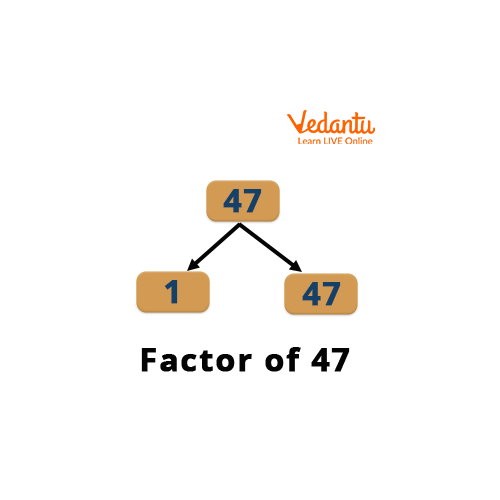




Factorisation of 47: Common Factors of 47, Pair Factors, Factor Tree and More
We can define factors of any number as an integer that divides another number by itself and leaves no remainder. So, if we multiply two whole numbers to produce a product, the numbers being multiplied are the factors of the result because this product is divisible by them.
For example, the integers 2 and 3 can divide the integer 6 without leaving any remainder; so, 2 and 3 are factors of 6. Factors of 47 are any integers that may be multiplied by another number to produce exactly 47. In other words, determining the factors of 47 is equivalent to breaking down the number 47 into all of the smaller components that can be put in a multiplication equation to equal 47.
Finding the Factors of 47 Using Division Method
In this section, we will learn how to find the factors of 47. There are several methods of finding the factors of an integer. Here, we will follow the Division Method. In this method, we start with 1 and check 2, 3, 4, 5, 6, 7 up to 23 (almost half of 47) to see if any numbers can divide 47 and leave zero as the remainder, then the corresponding divisor and quotient will be treated as the factors of 47.
A total of two factors are there: 1 and 47.
Prime Factorisation of 47
A prime number is a positive integer that has only two factors 1 and the number itself. For example, 2, 3, 5… etc.
One of the most useful methods of finding the factors of an integer is prime factorisation. In this method, we factorise an integer only into its prime factors. 47 is a known prime number. Therefore, 47 is the only prime factor 47. This can be easily understood by the following factor tree of 47:
Prime Factorisation of 47
Factor Tree of 47
The factors of 47 are 1 and 47. This can be easily understood by the following factor tree of 47:

Factor Tree of 47
Factors of 47 in Pairs
A pair of factors of 47 will be a pair of factors
Hence, by definition, the pair factor of 47 is (1,47).
Interesting Facts
Prime numbers have exactly two factors: 1 and that number itself.
Composite numbers have more than two factors.
1 is neither prime nor composite as it has only one factor i.e., 1, the number itself.
Solved Examples
Example 1: Find the sum of all the factors of 47.
Solution: To find the sum of all factors of 47, we need to find all the factors of 47 first. As we have discussed before, 47 has only two factors: 1 and 47.
Therefore, the sum of all the factors of 47 is (47+1)=48.
Example 2: Calculate the mean of all the factors of 47.
Solution: We are aware that 1 and 47 are the factors of 47.
In mathematics, mean is defined as the average of the provided numbers, which is determined by dividing the sum of the given numbers by the total number of terms.
The average of all the 47 factors is therefore 24.
Practice Problem
What is the lowest common multiple between 47 and 35?
What is the product of 47 factors?
Answers
1645
47
Conclusion
The factors of 47 can be obtained by several methods such as Division Method, Prime Factorisation Method, etc. It has a total of 2 factors: 1 and 47. The prime factorisation of 47 is 47. 47 is a prime number so its pair factor is (1,47). We hope this article helped you understand how to factor 47. Take out a pencil and piece of paper and try to practise the questions given above in this article by yourself.
FAQs on Factors of 47
1. Is the number 47 a perfect square?
47 isn't a perfect square because it doesn't have a natural integer as its square root. It ends with a 7, which is never a perfect square.
A perfect square is a number that is the product of two equal integers and here 47 is the product of 1 and 47 itself. Furthermore, its square root cannot be stated as a fraction of the form p/q, indicating that 47 is an irrational number.
2. Write the steps to find the greatest common factor of an odd number and an even number.
Let’s suppose an odd number is 47 and an even number is 10
The first step in determining the GCF of 47 and 10 is to list the factors of each number.
The Factors of 47: 1, 47 itself
The Factors of 10: 1, 2, 5, and 10 itself
We can therefore conclude that 1 is the greatest common factor or divisor among all of them because it is the largest number that divides equally into each of them.
These numbers are known as co-primes, coprime integers, or coprime numbers because their Greatest Common Factor is 1, which makes them.
3. Is 47 a composite number or a prime number?
The number 47 is a prime number. When we divide 47 by 1 and by 47, the remainder is zero. As a result, the factors for the number 47 are just 1 and 47. Given what we already know, a prime number is one that only has one factor—the number itself—and is referred to as a prime number. Composite numbers, on the other hand, have more than these two factors. Although 47 is a perfect square, it is an odd prime number.











